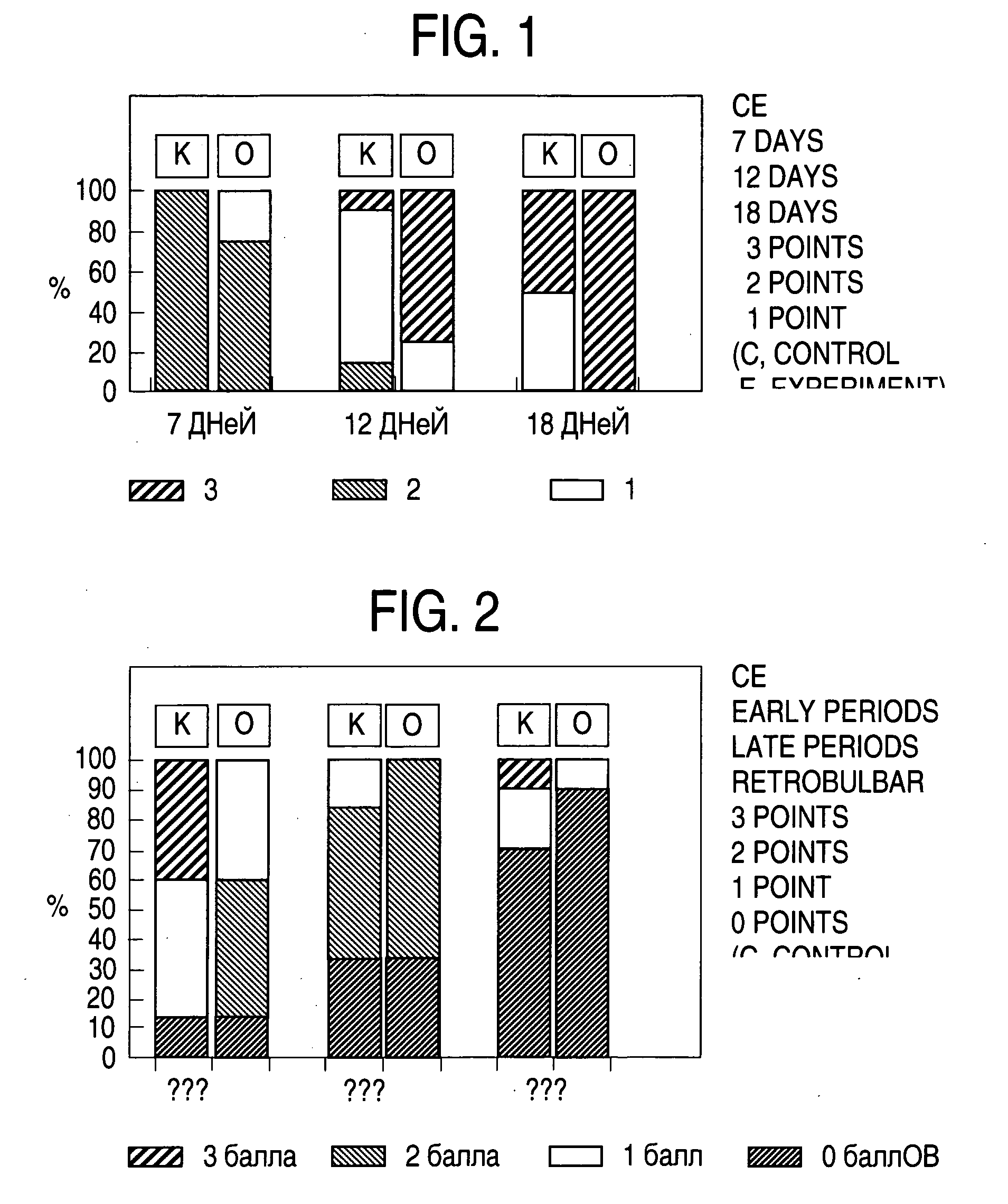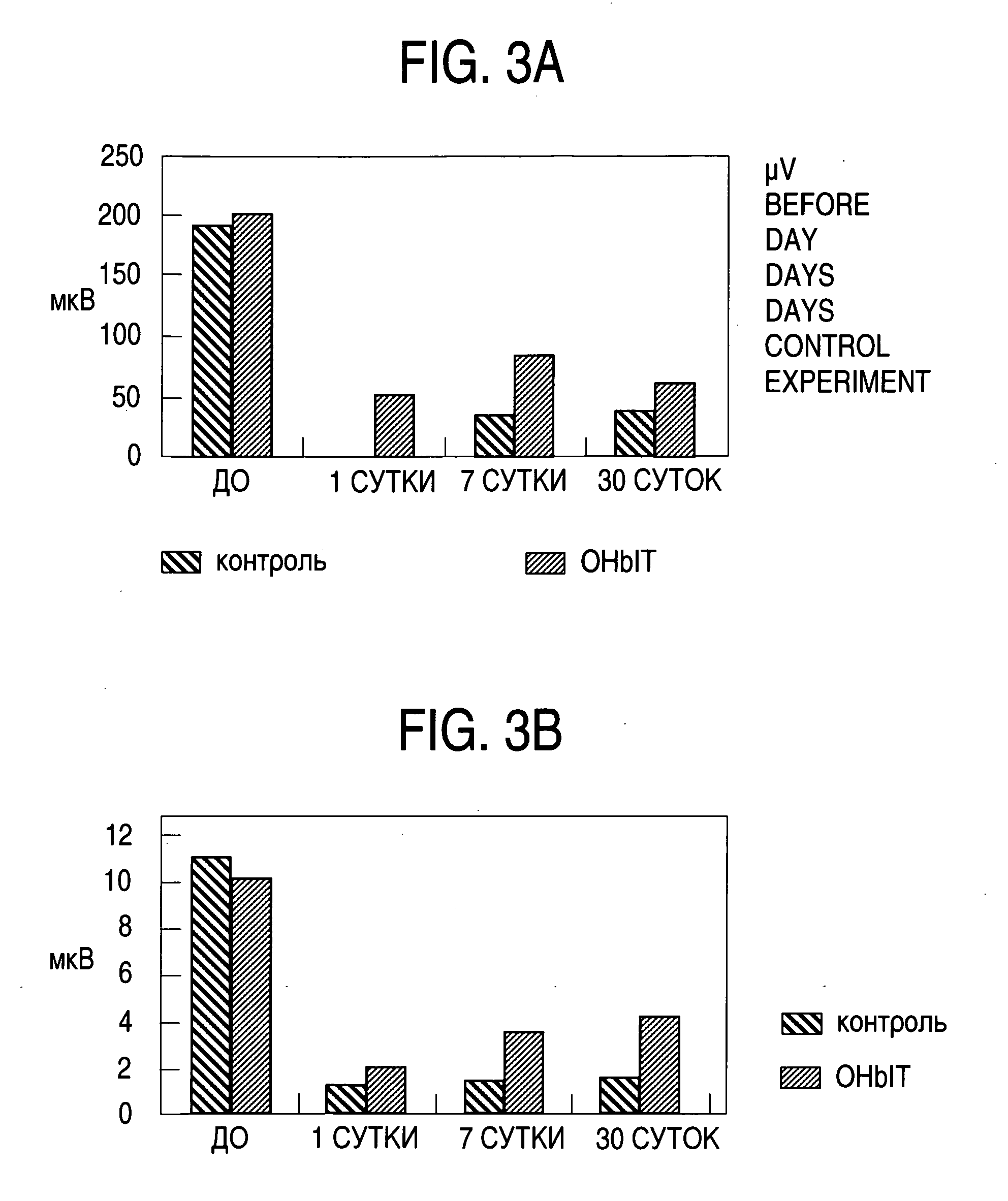Methods for reducing the side effects of ophthalmic laser surgery
a laser surgery and laser technology, applied in the field of stem cell therapy, can solve the problems of retinal detachment, vitreous hemorrhage, and retinal neovascularization often causing eye bleeding, and achieve the effects of reducing the risk of ophthalmic laser surgery side effects, and reducing the risk of ophthalmic surgery side effects
- Summary
- Abstract
- Description
- Claims
- Application Information
AI Technical Summary
Benefits of technology
Problems solved by technology
Method used
Image
Examples
example 1
Administration of Neural Stem Cells in the Treatment of Laser and Chemical Induced Retinal Damage
Materials and Methods
Tissue Isolation
[0098]Used as donor material were tissues of the forebrain of 7-12-week-old human embryos obtained from clinically healthy women artificially terminating pregnancy at periods corresponding to WHO recommendations accepted by the Ministry of the Russian Federation (Article No. 36, Order of the Ministry of Health No. 302 from Dec. 28, 1993). Aborted material was placed in a thermal container (4° C.) and delivered to a tissue culture laboratory no later than 5 hours after artificial termination of pregnancy. Fetuses free of visible developmental defects were treated with a disinfectant solution and transferred to cool F-12 medium (4° C.), after which the brain was totally isolated. The isolated tissue fragments were placed in petri dishes (60 mm, Costar, United States) containing 2 mL of F-12 medium and mechanically dissociated by multiple pipeting until ...
example 2
The Effect of Olfactory Ensheathing Cell Transplantation into the Suprachoroid Space on Recovery Of Retina after Laser Damage
Materials and Methods
[0156]Chinchilla rabbits (body mass 2.5 to 3.0 kg, n=15) were used throughout the study. Two types of laser damage were induced (see the Table 5)
TABLE 5Experimental groupGroup 1Group 2Extent of laserSmall laser burns (noCoagulation of blood vesselsdamagedeliberate attempts(produced large areas ofwere made to targetischemic damage)blood vessels)Laser power300 milliWatt600-800 milliWattFocused beam200 micron300 micronspot sizeLaser pulse100 millisecond100 milliseconddurationNumber of burn300 spots per eye100 spots per eyespotsSpots locationLower quadrants of theRetinal blood vesselsfunduswere coagulated with the laseralong their entire length. Zoneof coagulation was inside acircle centered around opticdisk. Circle radius was halfthe equatorial radius of theeye.Number of5 rabbits10 rabbitsanimalsInjection sitesupra-choroid spacesupra-choroid ...
example 3
The Effect of Human Mesenchymal Cell Transplantation in the Treatment of Retina Laser Damage
Materials and Methods
[0183]Chinchilla rabbits (body mass 2.5 to 3.0 kg, n=37) were used throughout the study. Laser-induced retinal damage was used as a model to simulate exudative macular degeneration in humans. Laser photocoagulation (200 μm spot size, 100 millisecond duration, 300 mW laser power ______ nm wavelength) was used to generate 300 laser spots in the lower quadrant(s) of each eye.
TABLE 11Animals were divided into 3 experimental groups:Exp.Exp.Exp.Group 1Group 2Group 3Number of human300,000 cells300,000 cells300,000 cellsmesenchymal cellsinjectedinjection siteinto theinto theinto thevitreous cavitysuprachoroidsuprachoroidspacespace (*)injection volume100 microL20 microL20 microLTime between human30 days30-40 days10-18 dayscell transplantationand animal euthanasiaMeasuring equipmentRetinoGrafRetinoGrafMjölner****ERG system Mjolner → http: / / www.globaleyeprogram.com / htm / mjolner.htm(*...
PUM
 Login to View More
Login to View More Abstract
Description
Claims
Application Information
 Login to View More
Login to View More - R&D
- Intellectual Property
- Life Sciences
- Materials
- Tech Scout
- Unparalleled Data Quality
- Higher Quality Content
- 60% Fewer Hallucinations
Browse by: Latest US Patents, China's latest patents, Technical Efficacy Thesaurus, Application Domain, Technology Topic, Popular Technical Reports.
© 2025 PatSnap. All rights reserved.Legal|Privacy policy|Modern Slavery Act Transparency Statement|Sitemap|About US| Contact US: help@patsnap.com



